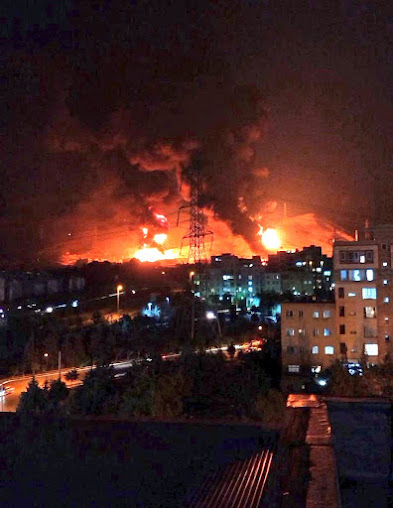The Iranian-Israeli Conflict
1. Historical Background
The Iranian–Israeli conflict has deep roots in ideological, political, and security rivalries. After Iran’s 1979 Islamic Revolution, Tehran adopted a hostile stance toward Israel and began supporting anti-Israel groups like Hezbollah and Hamas. Israel, perceiving Iran’s nuclear and missile ambitions as existential threats, started targeting Iranian assets through covert operations and strikes .
2. Key Events & Escalations
-
April 2024: Iran launched over 300 missiles and drones into Israel, resulting in limited damage but significant tensions .
-
October 2024: Iran’s “Operation True Promise II” involved ~200 ballistic missiles. Israel retaliated with “Operation Days of Repentance,” targeting nuclear and missile sites .
-
June 2025: Israel initiated “Operation Rising Lion,” striking nuclear facilities, missile bases, and command centers; Iran attacked Israeli cities with missiles and drones, causing casualties on both sides .
3. Recent Developments (Past Few Days)
-
Israel has intensively bombed over 100 of Iran’s nuclear/military targets including Natanz, Isfahan, and Tehran’s Defense Ministry HQ, killing senior officials and nuclear scientists .
-
Iran retaliated with waves of missiles and drones, hitting Tel Aviv, Haifa, and causing civilian and infrastructural damage, with dozens killed on both sides .
-
Over 400 Iranians and 14 Israelis dead; diplomacy stalled and regional tensions escalated .
4. The Role of Satellite Imagery
Satellite imagery has been pivotal in documenting and analyzing this conflict:
-
Evidence of Strikes: Photos show damage at Iran’s missile and nuclear sites in Parchin, Khojir, Natanz, Isfahan; and Israeli bases at Nevatim and Tel Nof .
-
Strategic Analysis: Images help assess remnants of radar installations, missile craters, and runway damages, assisting both nations in refining intelligence .
-
Public Insight: Private satellites like Planet Labs and Maxar have made some images publicly available, aiding journalists and analysts in verifying strike claims and extent of destruction .
5. Current Situations
🇺🇸🇮🇷 Iran’s Missile Barrage on Tel Aviv
On June 16, 2025, early Monday morning, Iran launched a fresh wave of over 100 ballistic missiles and drones at Israel, marking the fourth day of escalating conflict . Missiles struck Tel Aviv, Petah Tikva, and northern Israel. Powerful explosions triggered air-raid sirens, and at least 67 people were wounded, most moderately or lightly injured. Iran declared this retaliation for Israel’s strikes on its nuclear facilities and senior commanders .
🔥 The Broader Context
These recent attacks are part of a retaliatory cycle following Israel’s Operation Rising Lion, which struck Iranian nuclear and military infrastructure on June 13–15, reportedly killing over 224 in Iran and injuring more than 1,200. In response, Iran has launched over 270 missiles since June 13, with at least 22 penetrating Israel’s missile defenses, resulting in 14 deaths and hundreds injured .
🏙️ Impact on Tel Aviv & Civilians
-
Residential damage is reported in Tel Aviv and Petah Tikva, with buildings hit, windows blown out, and concrete surfaces scarred.
-
Casualties: 67 injured on Monday; previous waves also killed at least three civilians in the city .
-
Emergency response: Sirens have been blaring across central and northern Israel; shelters have been activated. Major cities remain on high alert .
🌍 Risk of Regional Expansion
The continuous missile exchanges have raised fears of a broader regional war. Countries like Britain have deployed military assets to the Middle East, while diplomatic efforts have stalled . The conflict has disrupted oil markets, impacted global flight paths, and sparked international condemnation alongside urgent calls for de-escalation.
⚠️ What’s Next?
-
High-alert status continues across Israeli cities; air defenses remain fully active.
-
Diplomatic pressure is intensifying, with international actors urging an immediate ceasefire.
-
Iran signals it won’t de-escalate until Israel suspends operations; Israel vows further retaliation if attacks persist .
This latest barrage targeting Tel Aviv is part of an ongoing cycle of retaliation. The situation remains volatile—any escalation could spread regional instability. I’ll keep tracking updates—let me know if you’d like satellite images of the impact or satellite intelligence analysis.
6. Conclusion & Outlook
The Israel–Iran conflict has escalated into direct strikes and strategic deterrence. Satellite imagery plays a critical dual role: guiding intelligence operations and ensuring transparency for global observers. As diplomatic channels collapse, the eyes in the sky are more vital than ever to understand this fast-moving conflict and its global consequences.




No comments:
Post a Comment